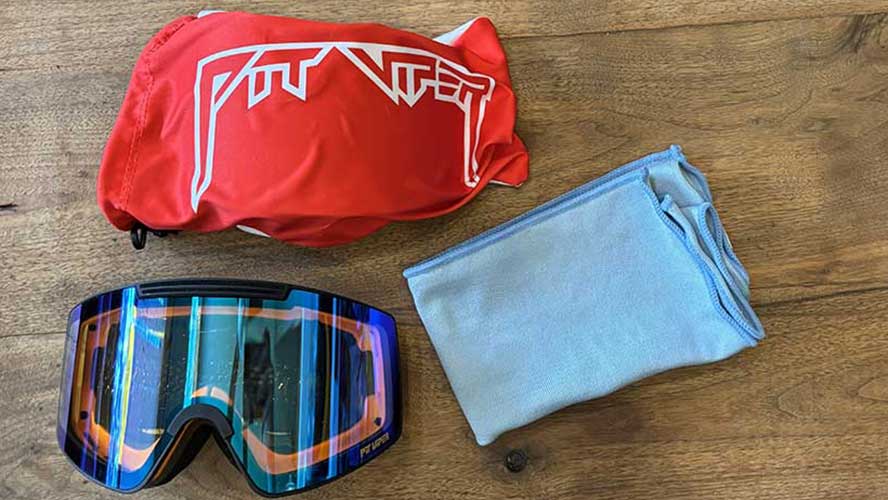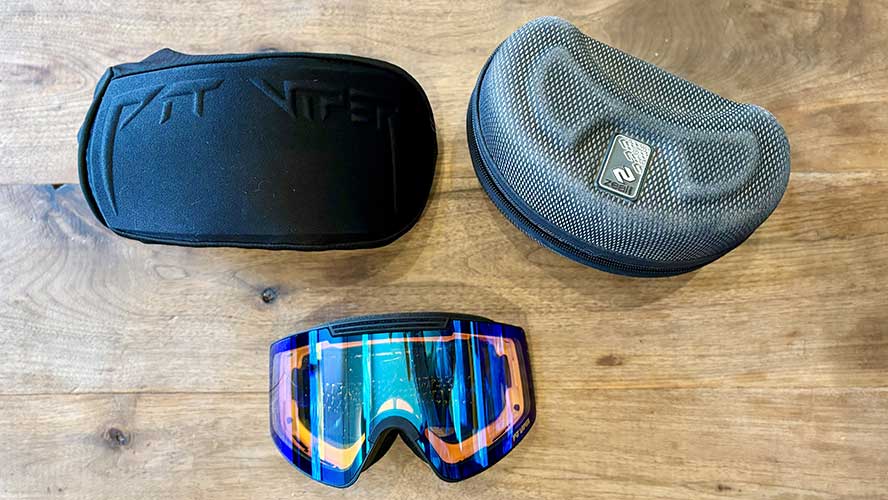There’s nothing better than getting off the chairlift and seeing an expansive mountain view. You look at the resort signs to see today’s open runs. You start to plan out your route and the excitement of your ski day builds. That is, until you can’t see out of your goggles. Whether they fog up or fall down, ski goggles are a crucial piece of gear both for everyone’s safety and enjoyment. Properly maintaining your ski goggles ensures your view of the mountain remains obstruction-free. This allows you to get the maximum line of sight to pick your line and ski safely. For both veteran and first-timers, learn why and how to care for your goggles and ski clearly this season.
Why Lens Care Matters
You can have the best skis and clothes, but if you can’t see where you’re going, what’s the point? Your first priority in goggle care is caring for your lenses. Maintaining your lenses is crucial for both vision and maximizing the longevity of your goggles– take care of your gear so it takes care of you.

Scratches and & Fog
All it takes is one big scratch right across the middle of the lens to have you thinking about buying new goggles. Scratched lenses can be distracting and even disorienting on the mountain.
Another major reason to be careful with your goggles is to prevent the lenses from fogging up. Your lenses have an inner lens and outer protective film. If moisture or debris gets in between those layers, your lenses will fog up making it difficult to see.
Even though a few scratches and some snow seem like “normal” wear and tear for ski gear, proper lens maintenance helps you avoid these issues and extends the life of your goggles. It saves you money and will keep your vision crisp and clear so you can ski or ride to your full potential. Below are recommendations on how to properly maintain your goggles, from cleaning to storage.
How to Clean Your Goggle Lenses
It is inevitable that snow, ice, water, or anything in between will get in or on your goggle lenses. Knowing how to properly clean goggle lenses helps keep you seeing clearly and extends the life of your gear. When cleaning your goggles, it is important to treat the outer lens and inner lens differently.
Outer Lens
If snow or ice gets on the outer lens, try your best to let it air dry. Wiping your wet and cold lens causes scratches from ice crystals or dirt in the snow. If you have to wipe the outer lens, try to let it dry and warm up a bit. Then, use a microfiber cloth or the cloth case that came with the goggles. It is very important to only use a microfiber cloth or the case, not your shirt or gloves. Clothes and gloves may seem soft, but they will likely scratch the lens if used for wiping.

If you’re prone to smudging your goggles while you’re skiing, throw a microfiber cloth in your coat pocket. Then, anytime you need to wipe your lenses you have a safe and effective way to remove snow and debris. If you really want convenience, you can purchase gloves and mittens with an included microfiber thumb patch so you can wipe your lens with ease.
Inner Lens
For the inner lens, less is more. If you get snow or water inside the goggles, do your best to live with it and let it dry. Most companies put an anti-fog coating on the inner lens, and wiping the inner lens will rub it away over time, causing your goggles to fog up more often.
How to Prevent Fogging
Fogged goggles can easily ruin your day. Unfortunately, we don’t live in a world where there are truly fog-free goggles, but with a few tips and best practices, you can greatly limit the fogging of your ski goggles.
Let Your Lens Be
The best way to prevent your goggles from fogging is to maintain the anti-fog coating on the inner lens. To do this, don’t touch it! It is best to leave the inside of the goggles alone as much as possible. If there is a smudge on the inside that must be wiped away, be gentle, and try and dab at it instead of wiping. Excess cleaning of the interior can wipe away the anti-fog coating which leads to more fogging.
Proper Storage
Another important way to prevent your goggles from fogging is proper overnight storage. Your goggles will most likely be wet after skiing. Store them without a case in a well-ventilated area. This allows the goggles to completely dry out and be ready for the next day. If you store your goggles wet, moisture will be trapped in the lens, and the entire next day will be a foggy one.
Dress for Success
Lastly, how you dress is an important way to reduce goggle fogging. Goggles fog because they get hot compared to the surrounding temperature. If you overheat by overdressing, your goggles are more likely to fog. Allow good airflow to the face region and clear any snow that gets on top of the goggles. If you find yourself overheating, take your goggles off for a minute to give them some air.
How to Store Your Goggles
On top of longevity, proper storage prevents scratches and water damage. Before we get into goggle cases and storage bags, it should be noted that when storing goggles overnight or longer, make sure they are dry! This applies to all storage cases and is especially important if you plan to use the goggles the next day.
Soft Case
Most goggles come with a soft goggle bag. Use it! These soft bags are made from a microfiber-like material that won’t damage the lens. If you are traveling or just driving home from the slopes, these soft bags are great for transporting your goggles safely. It is wise to carry this bag with you at all times, even when skiing, so if you need to put the goggles away, or give them a wipe, you can do so scratch-free.
Hard Case
A hard case has all the benefits of the soft goggle bag but adds protection against heavy objects such as skis and boots. If your goggles came with a hard-shell case, use it for air travel or any time when you have to place the goggles next to other objects.

Temperature
The final thing to consider when storing your goggles overnight or end-of-season is temperature. Goggles are best stored indoors, where it is an average and consistent room temperature. Significant temperature changes can harm the goggles so always bring them inside with you after a ski day and for summer storage.
How to Transport Your Goggles
Traveling for a ski vacation can be hard work. There is a lot of gear involved with skiing and transporting it carefully can be a balancing act. Luckily, goggles are a smaller piece of gear and transport well.
If you are flying to your ski destination, make sure your goggles are dry and stored in the hard-shell case. With the protection of a hard case, you can pack your goggles almost anywhere in your luggage. If your goggles did not come with a hard-shell case, use the soft goggle bag and wrap them in clothing. You can then lodge your goggles in one of your ski boots or helmet to keep them secure in transport.
Regardless of how often or how well you ski, proper goggle care is important for everyone. You don’t need to be an expert to take care of your gear, remember to keep it simple. Carry a microfiber cloth in your ski coat, invest in a hard case for your goggles, or just remember to bring everything inside at the end of the day so it can dry. Make your investment in ski goggles worth it and take care of them so they perform on the slopes when it matters most. One of the best things about skiing is taking in the beauty of the mountains, do your part to ensure that view is always a clear one.
By Jans Experts





